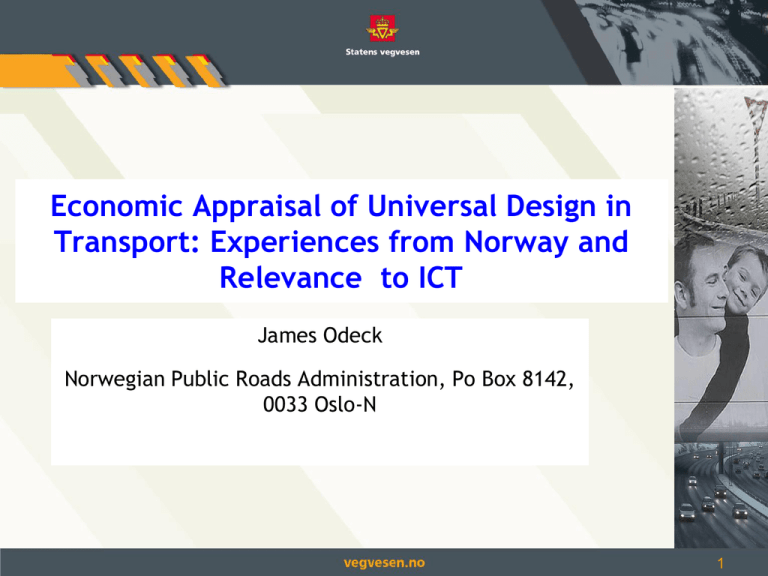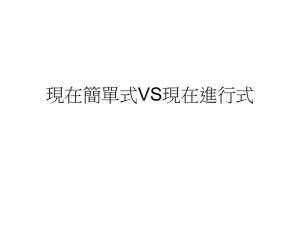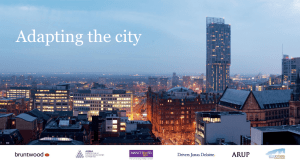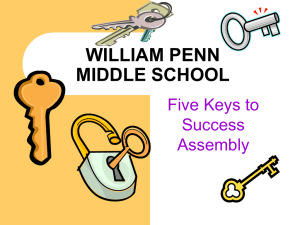Economic appraisal of Universal Design in transport: Experiences
advertisement

Economic Appraisal of Universal Design in Transport: Experiences from Norway and Relevance to ICT James Odeck Norwegian Public Roads Administration, Po Box 8142, 0033 Oslo-N 1 Background 1. Economic assessment of Universally Designed (UD) projects is lacking in the literature of transport planning 2. The concept of UD is not well understood by many in the transport sector and is taken to mean something like “design for the impaired” 3. Recently, The Norwegian Public Roads Administration (NPRA) and the Institute of Transport Economics (TOI) did some collaborative work on universal design that needs to shared with others working with economic assessment of eAccessibility 2 Four objectives: 1. Give an appropriate definition of UD in the context of road and public transport as adopted in Norway 2. Describe the types of UD projects and, benefits and costs that accrue to users if they are implemented 3. Address how the benefits and cost can be valued in monetary term and demonstrate the economic profitability of UD 4. Point out the similarities between economic assessment of Universal Design in Transport and e-accessibility 3 1. The definition of Universal Design (UD) • Universal Design refers to transport system or facility designs that accommodate the widest range of potential users, including but not limited to people with mobility and visual impairments (disabilities) and other special needs • The conventional thinking of the concept is that Universally Designed projects are aimed at the few e.g., the disabled or impaired - which is wrong ! • Stated differently, Universal Design benefits all types of users but is necessary for some 4 The Definition adopted by the NPRA Universal Design (UD) is the Design of infrastructure, transportation systems or their surroundings to accommodate the widest range of potential users regardless of their impairments or special needs UD is therefore necessary for some but benefits all users! An illustration follows 5 The case of a low-floored bus Foto: Lin Stensrud Foto: Knut Opeide Foto: Knut Opeide An illustration of benefits to all in the case of a lowfloored bus A low-floored bus in the first instance benefits wheelchair users and those with baby strollers In the second instance, because wheelchair and stroller users can get faster on board, all others users can also get faster onboard. Third, all others passengers on board also save travel time And finally, bus operators may increase their efficiencies Universal Design in this case benefits all users and not only the impaired! Foto: Lin Stensrud Similarities with eAccessibility from the past and why both Universal Design and eAccesibilty benefits all • Remote control for TVs were designed for the impaired – yet it benefits everybody today • Digital books were designed for the impaired – yet there are a benefit to everybody today • Wide screen TVs and PCs were designed for the impaired yet we all appreciate them • How about lifts in buildings? • How about cars with automatic gears? 2. The types of UD projects and benefits and costs that accrue to users Universal Design Low-floor bus Benefits Implementation of high curbstone at a bus stop Eases boarding and alighting the bus(comfort factor) for all passengers All passengers save time boading and alighting All passengers in the bus save time because boarding/alighting the bus is quicker Bus company obtains an efficiency effect due to time saving(not included in the analysis) Reduction of subsidies from the government due increased patronage( not included in the analysis) Eases boarding/alighting the bus(comfort factor) Costs Investment and manitenance of low floor bus Investment and manitenance of curbstones Enhanced lighting at bus stops All passengers save time boarding/alighting the bus Bus company obtains an efficiency effect due to time · saving Improved total overview Investment in lighting and maintenance Improved readability of information Increased sense of security and increased level of identification of approaching buses 12 Benefit-cost analysis (BCA) of UD projects • Not different from traditional BCA’s given that benefits and cost can be measured in monetary terms • It Involves the comparison of benefits against costs • Two decision rules: • Net Present Value (NPV) = net discounted benefits minus net discounted costs; then the project is economically profitable • Benefit-Cost Ratio = NPV/costs; select the project with the highest ratio 3. Valuing benefits and cost in monetary terms • Traditionally, there is a consensus about valuing impacts of transportation undertakings both in the road and the public transportation sector • Impacts of Universal Design are in many cases similar to those of traditional investments in transportation e.g., time savings. Some values of UD impacts can therefore be derived from existing handbooks • An initial way of deriving values is through literature survey • NPRA has derived values by combining literature survey and existing values. 14 Recommended NPRA values for UD projects Measure Bicycle parking at bus stop ** Nominal value Valuation in Source per trip Eurocents* NOK 4 54 Vibe et al 2004 Bus shelter NOK 0.60 13.1 Norheim 1996 Maintenance and cleaning of bus stop 11.8 pence 32 Steer Davies Gleave 1996 Timetable at bus stop SEK 2.00 42 Blomquist og Jansson 1994 Route map at bus stop NOK 0.40 8.8 Norheim 1996 Sign on board in bus indicating next stop SEK 2 30.4 Persson 2000 Sign on bus indicating final destination SEK 0.12-0.32 6.3 Widlert m fl 1989 Real time information at bus stop NOK 1.15 26.3 Hammer og Norheim 1993 Next stop information announced by driver NOK 1 15.3 Persson 2000 Cleanliness on board 11 pence 25.5 Accent Marketing and Research 2002 Lights at bus stop 3,1 pence 8.4 Steer Davies Gleave (1996) Guards at bus stop NOK 1.50 32.9 Norheim 1996 Emergency telephone at bus stop NOK 0.80 17.5 Norheim 1996 Lowfloor bus 2.8 pence 7.6 Steer Davies Gleave (1996) * Year 2005 prices, using 2005 exchange rate NOK8 = €1. *** Bicyclists only 3. BCA of three illustrative projects Low-floor bus Implementation Enhanced of high curbstone lighting at bus at a bus stop stops Initial data and assumptions: Investment cost of installation Annual operational and maintenance costs Projects life time Number of passengers using the low-floor bus per year Average load factor Number of passengers per year at bus stop Time savings per passenger due to innstallation(in minutes) 65 000 0 18 15 000 28 0.3 155 000 7 500 25 12 71 200 0.3 16 000 1 000 15 100 000 - Benefit-cost analysis Annual benefits for users Annual benefits for non-users Annual benefits for operators Sum annual benefits Present value of benefits(discounted over 25 years) Present value of costs (investment,operational and maint.) 12 300 0 795 13 095 194 175 -81 215 24 920 0 1887 26 807 397 497 -271 216 67 000 0 0 67 000 993 489 -37 988 96 717 1.2 72 037 0.3 947 903 25 Socioeconomic profitability Net present value(NPV) Benefit-cost ratio Low-floor bus High curbstone at a bus stop Enhanced lighting at bus stop Benefit-cost ratio(dicsounted over 25 years) 60 50 40 30 20 10 0 0 20000 40000 60000 80000 100000 120000 140000 160000 180000 200000 -10 No. of passengers per year Conclusion and policy implications • Universal Design should be considered seriously by governments as they benefit all users and are necessary for a group of users e.g., the impaired and the burdened. • The benefits and cost of Universal Design projects are possible to measure in monetary terms such that a benefit-cost analysis can be conducted. • The benefit-cost analysis of Universal Design shows that they general are a profitable form investments characterized by high benefits and low investment costs. • Finally, benefit-cost analysis of Universal Design projects are quite possible even though it is not possible to account for all factors which if accounted for will reveal even more of their benefits e.g., the patronage factor. Lessons for economic assessment of eAccessibility 1. Take the view that eAcessibility is for all and not only for those with special needs. 2. We need to make people understand (1) by showing examples 3. A starting point is the identification of the “project” i.e. is it “a web accessibility all”, “Design for all” 4. The second step is the identification of benefits followed by quantification in monetary terms – all these are possible 5. ”Study on Economic Assessment for Improving e-Accessibility Services and Products” under SMART 2009 seems to take these into account.






